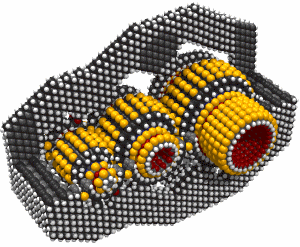HOW NANOTECHNOLOGY IMPROVES DAY-TODAY:
Continuing our Fantastic Voyage
Having considered some of the incredible ways that medical science is applying the knowledge of sub-molecular changes to deliver health benefits, this second part in the series links these with materials science and our everyday environments. .
Citing the development work of Greek scientist Dr Ioannis Arabatzis, it takes a look at some of the products produced by his company, Nanophos SA. Winner of the Gates’ foundations’ international prize for commercializing scientific research, his efforts to deliver practical benefits to everyday situations through technical excellence and inventiveness are seen as exemplary.
(E)merging building science
Despite the arguments over when and if nanotechnology and in particular nanobots will become available, as the previous article illustrates this is happening. Perhaps this is all the more so in nonmedical areas, which are subject to all sorts of test before they can be applied. This is particularly so in the area of Building Science, which is able to apply the same technology and techniques, but with far fewer restrictions and therefore faster market deliverability.
Based in Greece, ‘Nanophos SA’ is one company already delivering the benefits of Nanotechnology to address everyday problems in and around the home and other buildings to improve our lives.
Founded by scientist Dr Ioannis Arabatzis, Nanophos SA has developed a number of compounds for treating all kinds of products. Personally recognised by Bill Gates, founder of Microsoft, for the innovative nature of their work, NanoPhos and Dr Arabatzis are undoubtedly delivering cutting edge nanotech inventions to improve and add value to a wide range of everyday products.
Protecting and waterproofing surfaces from within
Bricks, concrete, marble and timber are just a few of the items surrounding us in everyday life that are susceptible to surface damage though staining, sunlight, mould and fungus. Unlike other compounds, for instance 2 component or silicon based treatments that create a ‘plastic film’ on the surface.
Instead of sealing off these pores, like the other treatments, they act below the surface to change the cellular structure of the material, enabling it to use chemical forces to repel water and other corroding factors.
Whereas surface barrier films are damaged or worn away by cleaning, abrasion and mechanical wear and tear, this below surface treatment gives truly long lasting protection to any material to which it is applied. Since non-particles do not form polymer chains, they also last longer, with 95% of their original functionality or activity being recorded after eight years.
This enhanced, long lasting protection is due to the unique method developed by SurfaPore to chemically anchor its nanoparticles onto the basic building material.
Avoiding colour change and UV damage
By eliminating the need to create a film or membrane to protect surfaces, formulations don’t change the colour or appearance of the surfaces to which they are applied. They are also more resistant to the ‘hard’ UV part of solar radiation and so are less susceptible to the yellowing and fade effects of sunlight.
‘Breathing’ surfaces
One very important advantage of that surfaces modified with an appropriate SurfaPore® nanocompound can still ‘breathe’ after application. What this means is that water vapour can still travel from and to the outside through the natural pores of the material because they are not trapped by a protective film or membrane.
While water itself is blocked from being transferred from the external environment to the inside of the material, moisture that has got into the substrate before application can still freely vaporise and evaporate to the environment, without accumulating behind the building’s surface.


.jpg)

.jpg)
